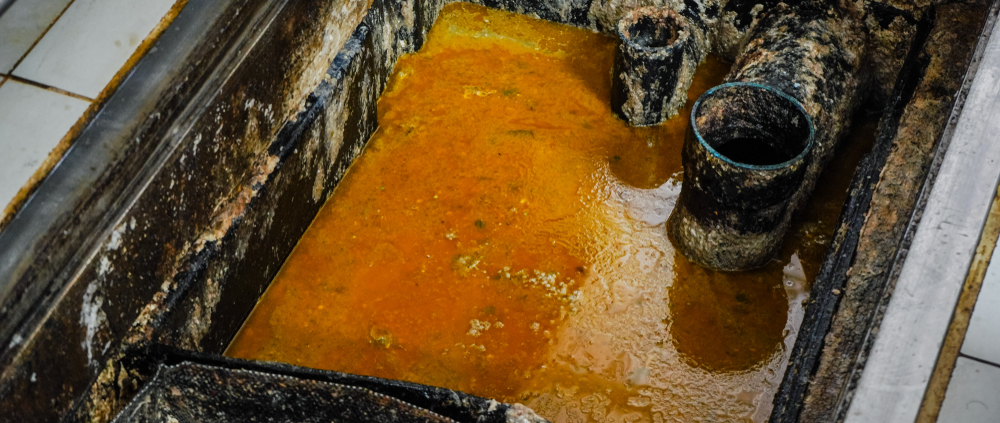5 Ways to Improve Your Grease Trap’s Maintenance
From small mom and pop restaurants to the massive chain eateries, staying on top of kitchen maintenance can be a tough assignment. While the majority of kitchen maintenance often revolves around keeping the more constantly used equipment such as sinks, ovens and fryers in tip-top shape, it can be easy to overlook the oh-so-important grease trap.
Ovens and fryers are more often than not viewed as the bread and butter of busy commercial kitchens, but in reality it’s the grease trap that seemingly holds together the entire functionality of the kitchen itself. It should come as no surprise then that regularly inspecting and maintaining the upkeep of your grease trap should be a top priority. To help keep your grease trap operating at 100% we’ve outlined five ways to improve your grease trap’s maintenance.
Grease Trap Maintenance: Install a Safeguard
Scraping excess food off plates into the disposal is a standard procedure that typically removes the majority of waste, but there’s always a small portion of runoff that finds its way down the sink. This has been a problem with smaller food such as corn or rice building up overtime and clogging the pipes. One way to counter this is to install protective screens under your sinks. These protective screens help prevent any excess food or grease that might still be on those plates from getting into your pipes and causing major headaches.
Avoid Using Garbage Disposals
In the past garbage disposals were seen as a savior for busy commercial kitchens that were looking for a quick fix to dispose of any excess food. Turns out those garbage disposals actually did more harm than good. All that ground up excess food and waste getting dumped down the sink was causing a serious clog in the grease trap pipes. If you’re not careful those small clogs can soon lead to massive backups and damage throughout the pipes. In small doses a garbage disposal can prove to be quite the effective tool, but for the massive busy kitchens a general rule of thumb should be to avoid if possible. Try composting!
Keep a Lower Water Temperature
There’s a strong likelihood that your restaurant is using hot water to wash dishes. This is completely fine, but when that water temperature exceeds 144 degrees it will essentially melt off of the fats, oils and grease which in turn leads to them being drained through screens and grease traps. Those same fats, oils and grease will then slowly start to build up overtime, solidifying and becoming a potentially serious problem. Making matters worse is that if these substances get into the sewer and cause a problem your establishment could be hit with hefty fines.
Remind Employees What Can and Can’t go Down the Sink
It might seem redundant at times, but constantly reminding employees what can and can’t go down a sink is a simple way to better protect your grease trap. This is especially true if the kitchen you work in is always busy or you have an inexperienced staff. Keep signs posted above sinks and around disposal areas to remind employees. The more you can educate your employees on avoiding dumping those fats, oils and grease down the drain, the more you’ll be protecting your grease trap from further harm.
Don’t Let Spills Linger
This is pretty obvious for a wide variety of reasons, but it’s imperative to clean up any spills or accidents in the kitchen as soon as it happens. Every kitchen, big or small, is going to have spills at some point. Whenever food gets spilt, whether it’s soup, sauces, cooking oil, or nearly every other item, it can quickly make its way down the drain if you aren’t on top of it. Again, this goes back to educating your employees, as the last thing you’ll want to do is mop any sort or greasy spill down the drain. It’s a common mistake for inexperienced workers but can lead to serious problems on your grease trap. Best practices should be to clean messes with a towel and then dispose of it into the garbage.
Keep Your Grease Trap in Tip-Top Shape
Fats, oils and grease are prominent in every kitchen. It’s impossible to completely prevent those kitchen culprits out of your pipes entirely, but adapting to a bend, don’t break strategy is the best option for keeping your kitchen running smoothly. Your grease trap is essentially your last line of defense, as it works tirelessly to keep those fats, oils and grease from reaching the sewer and causing serious kitchen nightmares. The more you can do to protect and maintain your grease trap, the less you’ll have to worry about potential problems with your pipes.
Contact the team at Hulsey (a Blue Flow Company) today to learn more about the best practices and strategies for keeping your grease trap in tip-top shape!




Leave a Reply
Want to join the discussion?Feel free to contribute!